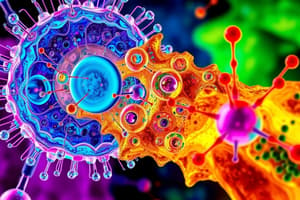Podcast
Questions and Answers
The dye glows brightly against a light background because only the emitted wavelength is allowed to reach the eye pieces or camera port of the microscope.
The dye glows brightly against a light background because only the emitted wavelength is allowed to reach the eye pieces or camera port of the microscope.
False (B)
Electrons have wave-like properties, and their wavelength depends on their speed.
Electrons have wave-like properties, and their wavelength depends on their speed.
True (A)
Electrons at 60 KV have an apparent wavelength of 0.005 mm in electron microscopy.
Electrons at 60 KV have an apparent wavelength of 0.005 mm in electron microscopy.
False (B)
The resolving power in electron microscopy is primarily limited by specimen contrast and perfect electromagnetic lenses.
The resolving power in electron microscopy is primarily limited by specimen contrast and perfect electromagnetic lenses.
There are three types of electron microscopes: TEM, SEM, and STM.
There are three types of electron microscopes: TEM, SEM, and STM.
In a transmission electron microscope (TEM), electrons produced by a pin-shaped cathode are vacuumed up by high voltage at the cathode.
In a transmission electron microscope (TEM), electrons produced by a pin-shaped cathode are vacuumed up by high voltage at the cathode.
Direct rays are of lower intensity when impeded by the phase plate.
Direct rays are of lower intensity when impeded by the phase plate.
In brightfield illumination, cells appear semi-transparent with all regions visible.
In brightfield illumination, cells appear semi-transparent with all regions visible.
U/V light increases resolution four-fold in comparison to white light in a microscope.
U/V light increases resolution four-fold in comparison to white light in a microscope.
Ultra violet microscopy uses specimens that can absorb U/V light and re-emit it as light of shorter wavelength.
Ultra violet microscopy uses specimens that can absorb U/V light and re-emit it as light of shorter wavelength.
One of the main disadvantages of ultra violet microscopy is the need for expensive quartz lenses.
One of the main disadvantages of ultra violet microscopy is the need for expensive quartz lenses.
Phase contrast microscopy makes the background darker and parts of the specimen brighter.
Phase contrast microscopy makes the background darker and parts of the specimen brighter.
Phase-contrast microscopy is a commonly used method to examine living cells without staining them.
Phase-contrast microscopy is a commonly used method to examine living cells without staining them.
Bright-field illumination makes living cells clearly visible due to significant light absorption differences.
Bright-field illumination makes living cells clearly visible due to significant light absorption differences.
Staining cells with dyes is a common method used in phase-contrast microscopy to enhance visibility of living cells.
Staining cells with dyes is a common method used in phase-contrast microscopy to enhance visibility of living cells.
In phase-contrast microscopy, the contrast in the image is produced by the differences in colour and intensity of illumination.
In phase-contrast microscopy, the contrast in the image is produced by the differences in colour and intensity of illumination.
Amplitude in light microscopy is a measure of color, while wavelength is a measure of brightness.
Amplitude in light microscopy is a measure of color, while wavelength is a measure of brightness.
Dark-field microscopy is more effective than phase-contrast microscopy in examining living cells without staining.
Dark-field microscopy is more effective than phase-contrast microscopy in examining living cells without staining.
Flashcards are hidden until you start studying




